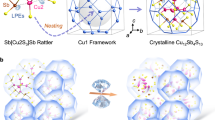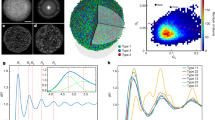Abstract
Solids are generally classified into three categories based on their atomic arrangement: crystalline, quasicrystalline and amorphous1,2,3,4. Here we report MgO and Nd2O3 ceramic phases with special atomic arrangements that should belong to a category of solids different from these three well known categories by combining state-of-the-art atomic-resolution scanning transmission electron microscopy and first-principles calculations. The reported solid structure exhibits a one-dimensional (1D) long-range order with a translational periodicity and is composed of structural units that individually have atomic arrangements similar to those observed in coincidence-site lattice configurations present at grain boundaries. Regardless of the insulating nature of the bulk MgO, the bandgap of which is measured to be 7.4 eV, the MgO 1D ordered structure is a wide-bandgap semiconductor with a bandgap of 3.2 eV owing to this special atomic arrangement. The discovery of 1D ordered structures suggests that the structural categories of solids could be more abundant, with physical properties distinct from their regular counterparts.
This is a preview of subscription content, access via your institution
Access options
Access Nature and 54 other Nature Portfolio journals
Get Nature+, our best-value online-access subscription
$29.99 / 30 days
cancel any time
Subscribe to this journal
Receive 12 print issues and online access
$259.00 per year
only $21.58 per issue
Buy this article
- Purchase on Springer Link
- Instant access to full article PDF
Prices may be subject to local taxes which are calculated during checkout




Similar content being viewed by others
Data availability
The data that support the findings of this study are available from the corresponding authors upon reasonable request.
References
Hook, J. R. & Hall, H. E. Solid State Physics 2nd edn (John Wiley & Sons, Chichester, 2010).
Shechtman, D., Blech, I., Gratias, D. & Cahn, J. W. Metallic phase with long-range orientational order and no translational symmetry. Phys. Rev. Lett. 53, 1951–1953 (1984).
Levine, D. & Steinhardt, R. Quasicrystals: a new class of ordered structures. Phys. Rev. Lett. 53, 2477–2480 (1984).
Zollen, R. The Physics of Amorphous Solids (Wiley, New York, 1983).
Yacamán, M. J. & Torres, M. Crystal-quasicrystal Transitions (North-Holland, Amsterdam, 1993).
Waseda, Y. The Structure of Non-crystalline Materials: Liquids and Amorphous Solids (McGraw-Hill, New York, 1980).
Sutton, A. P. & Balluffi, R. W. Interfaces in Crystalline Materials (Clarendon Press, Oxford, 1995).
Wolf, D. & Yip, S. Material Interfaces (Chapman & Hall, London, 1992).
Sutton, A. P. & Vitek, V. On the structure of tilt grain boundaries in cubic metals I. Symmetrical tilt boundaries. Phil. Trans. R. Soc. A 309, 1–36 (1983).
Gleiter, H. On the structure of grain boundaries in metals. Mater. Sci. Eng. 52, 91–131 (1982).
Grimmer, H., Bollmann, W. & Warrington, D. H. Coincidence-site lattices and complete pattern-shift lattices in cubic-crystals. Acta Crystallogr. A 30, 197–207 (1974).
Wang, Z. C. et al. Atom-resolved imaging of ordered defect superstructures at individual grain boundaries. Nature 479, 380–383 (2011).
Buban, J. P. et al. Grain boundary strengthening in alumina by rare earth impurities. Science 311, 212–215 (2006).
Inoue, K., Saito, M., Chen, C. L., Kotani, M. & Ikuhara, Y. Mathematical analysis and STEM observations of arrangement of structural units in <001> symmetrical tilt grain boundaries. Microscopy 65, 479–487 (2016).
Inoue, K., Saito, M., Wang, Z. C., Kotani, M. & Ikuhara, Y. On the periodicity of <001> symmetrical tilt grain boundaries. Mater. Trans. 65, 281–287 (2015).
Bean, J. J. et al. Atomic structure and electronic properties of MgO grain boundaries in tunneling magnetoresistive devices. Sci. Rep. 7, 45594 (2017).
Mo, S. D. & Ching, W. Y. Electronic and optical properties of ɵ-Al2O3 and comparison to ɑ-Al2O3. Phys. Rev. B 57, 15219–15228 (1998).
Cui, H. J. et al. The geometric and electronic transitions in body-centered-tetragonal C8: a first principles study. Carbon 120, 89–94 (2017).
Mckenna, K. P. & Shluger, A. L. Electron-trapping polycrystalline materials with negative electron affinity. Nat. Mater. 7, 859–862 (2008).
Pennycook, S. J. & Boatner, L. A. Chemically sensitive structure-imaging with a scanning transmission electron microcrope. Nature 336, 565–567 (1988).
Shibata, N., Oba, F., Yamamoto, T. & Ikuhara, Y. Structure, energy and solute segregation behaviour of [110] symmetric tilt grain boundaries in yttria-stabilized cubic zirconia. Philos. Mag. 84, 2381–2415 (2004).
Kirkland, E. J. Advanced Computing in Electron Microscopy (Plenum, New York, 1998).
Kresse, G. & Furthmüller, J. Efficient iterative schemes for ab initio total-energy calculations using a plane-wave basis set. Phys. Rev. B 54, 11169–11186 (1996).
Kresse, G. & Furthmüller, J. Efficiency of ab-initio total energy calculations for metals and semiconductors using a plane-wave basis set. Comput. Mater. Sci. 6, 15–50 (1996).
Blochl, P. E. Projector augmented-wave method. Phys. Rev. B 50, 17953–17979 (1994).
Perdew, J. P. et al. Atoms, molecules, solids, and surfaces – Application of the generalized gradient approximation for exchange and correlation. Phys. Rev. B 46, 6671–6687 (1992).
Monkhorst, H. J. & Pack, J. D. Special points for Brillouin-zone integrations. Phys. Rev. B 13, 5188–5192 (1976).
Feynman, R. Force in molecules. Phys. Rev. 56, 340–343 (1939).
Blöchl, P. E., Jepson, O. & Andersen, O. K. Improved tetrahedron method for Brillouin-zone integrations. Phys. Rev. B 49, 16223–16233 (1994).
Heyd, J., Scuseria, G. E. & Ernzerhof, M. Hybrid functionals based on a screened Coulomb potential. J. Chem. Phys. 118, 8207–8215 (2003).
Heyd, J. & Scuseria, G. E. Efficient hybrid density functional calculations in solids: Assessment of the Heyd–Scuseria–Ernzerhof screened Coulomb hybrid functional. J. Chem. Phys. 121, 1187–1192 (2004).
Garza, A. J. & Scuseria, G. E. Predicting band gaps with hybrid density functional. J. Phys. Chem. Lett. 7, 4165–4170 (2016).
Acknowledgements
A part of this study was supported by Grant-in-Aid for Specially Promoted Research (Grant No. JP17H06094) from the Japan Society for the Promotion of Science (JSPS) and the ‘Nanotechnology Platform’ (Project No. 12024046) of MEXT. C.C. is grateful for support from the Key Research Program of Frontier Sciences, CAS (No. QYZDY-SSW-JSC027), the National Natural Sciences Foundation of China (No. 51771200), and the ‘Thousand Youth Talents Plan’ of China. D.Y. acknowledges support from the National Natural Science Foundation of China (No. 11332013). The computation in this work was partly done using the facilities of the Supercomputer Center, the Institute for Solid State Physics, the University of Tokyo. We thank M. Kotani of Tohoku University for useful discussions and H. Ohno and S. Ikeda of Tohoku University for providing the present MgO samples. We thank S. Kobayashi of Japan Fine Ceramics Center and J. Wei of University of Tokyo for assisting with the EELS analysis.
Author information
Authors and Affiliations
Contributions
D.Y. performed the calculations. C.C. and M.S. conducted the experiments. C.C. and D.Y. wrote the paper. K.I. supported the calculation and discussed the results. C.C. and Y.I. directed the entire study. All authors read and commented on the paper.
Corresponding authors
Ethics declarations
Competing interests
The authors declare no competing interests.
Additional information
Publisher’s note: Springer Nature remains neutral with regard to jurisdictional claims in published maps and institutional affiliations.
Supplementary information
Rights and permissions
About this article
Cite this article
Yin, D., Chen, C., Saito, M. et al. Ceramic phases with one-dimensional long-range order. Nature Mater 18, 19–23 (2019). https://doi.org/10.1038/s41563-018-0240-0
Received:
Accepted:
Published:
Issue Date:
DOI: https://doi.org/10.1038/s41563-018-0240-0
This article is cited by
-
Induction of functional neutrophils from mouse fibroblasts by thymidine through enhancement of Tet3 activity
Cellular & Molecular Immunology (2022)
-
Phases at the interface
Nature Materials (2021)
-
Dimensional transformation of chemical bonding during crystallization in a layered chalcogenide material
Scientific Reports (2021)
-
Directional massless Dirac fermions in a layered van der Waals material with one-dimensional long-range order
Nature Materials (2020)
-
Direct observation of potential phase at joining interface between p-MgO and n-MgFe2O4
Scientific Reports (2020)



